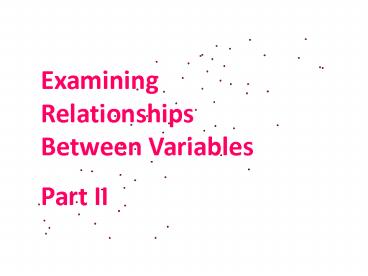Examining Relationships Between Variables PowerPoint PPT Presentation
Title: Examining Relationships Between Variables
1
Examining Relationships Between Variables Part II
2
- Relationship between two quantitative variables
measured on the SAME individuals
3
- Start
- With
- A
- Scatterplot
4
- IF Explanatory Response Relationship
- then
- Put explanatory variable on the x-axis
- and
- Put the response variable on the y-axis
5
- Look at the scatterplot
- Overall pattern
- Striking deviations
6
- Look at the scatterplot
- Form Linear or non-Linear
- Direction Positive or negative
- Strength Strong, weak, moderately strong or
weak - OUTLIERS?
7
- IF roughly linear
- Then
- Calculate correlation coefficient, r
- Which quantifies the direction and strength of
the LINEAR relationship between the two variables.
8
Correlation Can we rely on our eye to judge the
strength of the relationship between two
variables?
9
Correlation Coefficient r Numerical measure of
the strength and direction of the relationship.
10
(No Transcript)
11
Average of the sum of the products of the
standardized variables using n-1 degrees of
freedom.
12
r is positive when the association is positive r
is negative when the association is
negative. WHY?
13
Negative
Positive
Negative x Negative Positive Positive x
Positive Positive Negative x Positive Negative
14
- FACTS ABOUT CORRELATION
- No distinction between x and y or explanatory and
response variables.
15
- Both variables must be quantitative.
16
r has no units. So r doesnt change if we
change the units of the variable.
17
- -1 lt r lt 1
- -1 means perfectly linear in negative direction.
- 1 means perfectly linear in positive direction
- 0 means no linear relationship
18
- The relationship must be
- LINEAR
19
- r is not resistant to outliers
20
- A study measured the physical strength of 200
college men. One variable was the number of
pull-ups a subject could do. Other variables
included number of push-ups, number of sit-ups,
and body weight. The correlations of pull-up
count with these three variables were - r -0.150 r 0.190 r
0.647 - Which r goes with which variable?
- www.whfreeman.com/tps3e
21
- www.whfreeman.com/tps3e
- 3.29
- 3.31
- 3.34
- 3.36
22
- The End
PowerShow.com is a leading presentation sharing website. It has millions of presentations already uploaded and available with 1,000s more being uploaded by its users every day. Whatever your area of interest, here you’ll be able to find and view presentations you’ll love and possibly download. And, best of all, it is completely free and easy to use.
You might even have a presentation you’d like to share with others. If so, just upload it to PowerShow.com. We’ll convert it to an HTML5 slideshow that includes all the media types you’ve already added: audio, video, music, pictures, animations and transition effects. Then you can share it with your target audience as well as PowerShow.com’s millions of monthly visitors. And, again, it’s all free.
About the Developers
PowerShow.com is brought to you by CrystalGraphics, the award-winning developer and market-leading publisher of rich-media enhancement products for presentations. Our product offerings include millions of PowerPoint templates, diagrams, animated 3D characters and more.

